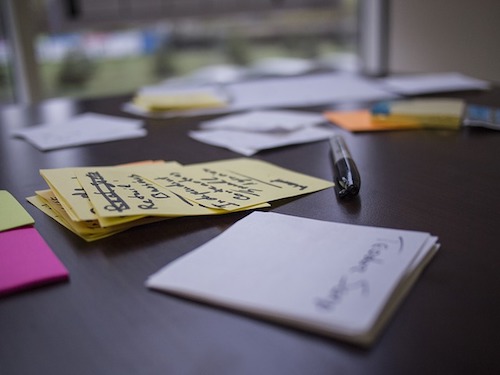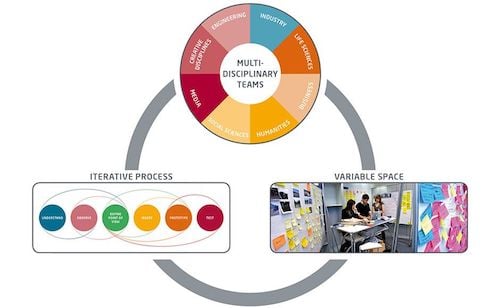10 principles that make Design Thinking successful
Design Thinking is a problem-solving tool that we use successfully in innovation processes. It is a very effective method that can be used for digital and physical products, services, processes or business models. Important success factors for Design Thinking projects are presented in this article.

1. Explore the user and his needs intensively
The first step in Design Thinking is to empathize with users to find out what the real problem is and what the user's needs are. In practice, too little attention and time is usually given to this phase. For example, you commission some interviews from a market research institute and build the Design Thinking process on them. In the course of the project, it turns out that the problems lie completely elsewhere.
„If I had only one hour to save the world, I would spend fifty-five minutes defining the problem, and only five minutes finding the solution."
(Albert Einstein)
It is therefore very important to really get to the bottom of the customer's problems. This requires a holistic view of the customer with his real needs, emotions and sensitivities. In addition to interviews, methods such as buyer personas, customer experience design, participating observations, the Lead user method, process analyses, empathy maps or focus groups are suitable.
2. Put together a heterogeneous team
Put together an interdisciplinary Design Thinking Team of five to six people to bring together as many different experience stands as possible at one table. Collaboration between people from different disciplines enables you to look at problems from different perspectives and to come up with completely new ideas as solutions. When putting together a team, make sure that there is a common focus and that there is no competition.
3. Avoid outsourcing process phases
If you seriously want to implement a design thinking project in a company, the interdisciplinary team should carry out all phases itself and not outsource individual areas to external service providers. Design Thinking is about working together on a project. All team members are involved in each phase and play a role.
Position claims in the sense of "I am a product manager, I certainly don't do interviews" would be a fundamentally wrong approach. Every team member should have a deep understanding of the problems, as the subsequent phases of idea generation and prototype development ultimately build on this understanding. It is of course easier to gain this understanding if team members implement all phases themselves and also take on unusual tasks that do not correspond to their traditional functions in the company.
4. Provide a mobile workplace and sufficient material
A creative process needs an environment in which ideas can flourish and prototypes can be developed. In Design Thinking projects you often approach the topic very playfully. For example, situations in the form of stories or sketches that you have seen at the customer or user are replayed. The Design Thinking Team therefore needs a workplace that is as flexible as possible and can be adapted quickly and easily to the needs of the team members. Flipcharts, whiteboards and tables on castors are best suited to redesign the room as it is needed. In addition, there should be enough material available to visually present ideas.
5. Have the courage to fail
Fail early and fail often! Design thinking is based on an iterative process. If you start all over again after the customer's feedback on your prototype, you are on the right track. You have saved a lot of time and money, because you have already found out before the implementation of the idea that it will fail on the market. With Design Thinking you need the courage to go through several loops. Innovation needs failure. You learn from feedback and improve through repetition. Of course, in a world where failure is frowned upon, this approach can be challenging. Then it depends on whether you really have the courage to fail.

Source: HPI School of Design Thinking
6. Allow even crazy ideas to happen
The last two steps of a design thinking process are to generate ideas and develop prototypes from them, which are then tested at the customer's site. The more ideas the better" always applies with regard to idea generation. Be experimental, think outside the box and allow crazy ideas - anything is possible! Get away from conventional ideas and collect as many ideas as possible. It's also important to learn how to throw away an idea for a better solution - even if it's your own idea that you have to throw away.
7. Start prototype development quickly
Design thinking doesn't mean sitting in a room all day discussing colorful post-its. Rather, it's about "thinking with your hands" and developing prototypes as quickly as possible. In practice, we often experience in companies that support from a moderator or facilitator is needed in this phase. After many years at the desk, many people are simply no longer used to designing something with their hands. Initially, this inhibition threshold often has to be overcome in order for the team members to get started.
8. Don't fall in love with your first prototype
People love to fall in love with their first prototype - especially when they haven't created anything with their hands for a long time. However, the first prototype is usually not the best solution. Hence the well-known statement "Burn your prototype - the first is never the best! In order to make rapid progress and gradually come closer to the best solution, it is also important to have the courage to say goodbye to the prototypes you have come to love („Kill your darlings“).
9. Put the function of the prototype in the foreground, not the design
If you test a prototype that is beautiful to look at, there is a risk that the test user will evaluate the design and not the functionality. So in design thinking projects, prototypes are all about building the most important features - without looking at the design. For example, this could be a simple visual aid that embodies the product as the end user will experience it.
10. Acting with an open mind
Openness to results for the best solution is an important principle in design thinking. This means that the result may not correspond to the existing ideas. For example, a company wants to develop a digital product because market research says that customers prefer digital products. But if you find out during the process that the customer's problem can be solved much better in a non-digital way, then this is an important finding that saves money and frustration.
Conclusion: Design Thinking focuses on customer needs
Many innovations fail on the market because they do not bring added value to the customer. To avoid this, Design Thinking shifts the focus from a purely technical solution to a human solution: Design Thinking is an innovation approach that focuses on customer needs and gradually approaches the best solution via iterative feedback loops. This allows user needs to be identified, innovative ideas to be evaluated or solutions for complex interdisciplinary problems to be found.
„Design Thinking is a method of meeting people's needs and desires in a technologically feasible and strategically meaningful way.“
Tim Brown











